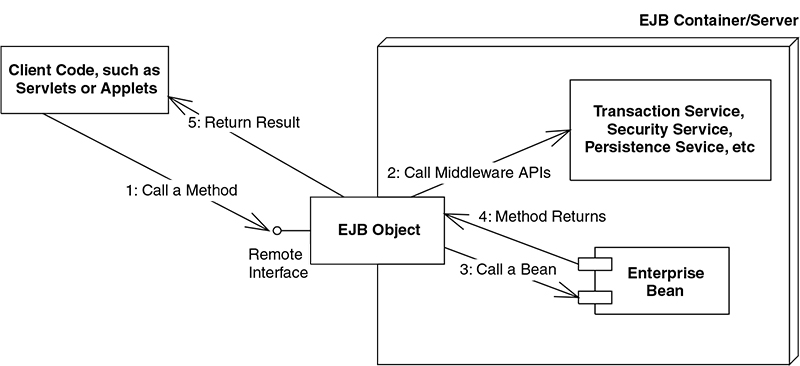Lesson 7
Entity Bean Client Conclusion
This module introduced the client side of the entity bean client. You learned how the home interface provides a
You were shown how, once the bean was found, to call the bean's business methods, and to remove the bean. The final lessons introduced the identity of the entity bean instances and how to compare them.
create() method to create both the bean instance and the underlying data. Subsequent lessons introduced the findByPrimaryKey() method It is the way that the client requests the home interface to find a particular entity and associate it with a bean instance. You were shown how, once the bean was found, to call the bean's business methods, and to remove the bean. The final lessons introduced the identity of the entity bean instances and how to compare them.
Thus, the EJB container acts as a layer of indirection between the client code and the bean. This layer of indirection manifests itself as a single network aware object called the EJB object. The EJB object is the request interceptor.
The EJB object is a surrogate object that knows about networking, transactions, security, and more. It is an intelligent object that knows how to perform intermediate logic that the EJB container requires before a method call is serviced by a bean class instance. An EJB object is the request interceptor, or the glue, between the client and the bean. EJB objects replicate and expose every business method that the bean itself exposes. EJB objects delegate all client requests to beans. We depict EJB objects in Figure 4.7
The EJB object is a surrogate object that knows about networking, transactions, security, and more. It is an intelligent object that knows how to perform intermediate logic that the EJB container requires before a method call is serviced by a bean class instance. An EJB object is the request interceptor, or the glue, between the client and the bean. EJB objects replicate and expose every business method that the bean itself exposes. EJB objects delegate all client requests to beans. We depict EJB objects in Figure 4.7

Hereâs a breakdown of the component parts and interactions labeled in the diagram:
-
1. Client Code (e.g., Servlets or Applets)
- This is the calling component (typically on the web tier) that initiates the interaction.
- Step 1: The client code calls a method on the
EJB Objectthrough the Remote Interface.
-
2. EJB Object
- Acts as a proxy between the client and the business logic implemented in the enterprise bean.
- Step 2: It calls middleware APIs, which might include services like:
- Transaction Management
- Security
- Persistence
- Other container-managed services provided by the EJB container.
-
3. Enterprise Bean
- This is the actual business logic component (Session Bean, Entity Bean, or Message-driven Bean).
- Step 3: The
EJB Objectinvokes the enterprise bean's method to perform business operations.
-
4. Method Returns
- Step 4: The enterprise bean completes its task and returns the result to the
EJB Object.
- Step 4: The enterprise bean completes its task and returns the result to the
-
5. Return Result
- Step 5: The result is sent back to the client code, completing the round-trip.
- This is the execution environment where:
- EJB objects and beans reside.
- Middleware services (like transaction, security, persistence) are provided.
- It handles lifecycle, security, transactions, and resource management for EJBs.
Summary of Interaction Flow
- Client calls method on EJB object.
- EJB object calls middleware APIs.
- EJB object invokes the enterprise bean.
- Enterprise bean returns a result to EJB object.
- EJB object returns the result to the client.
BMP - Exercise
Click the Exercise link below to complete the next part of the course project in which you create an instance of an entity bean.
BMP - Exercise
The next module discusses the home and remote interfaces of an entity bean.
BMP - Exercise
The next module discusses the home and remote interfaces of an entity bean.